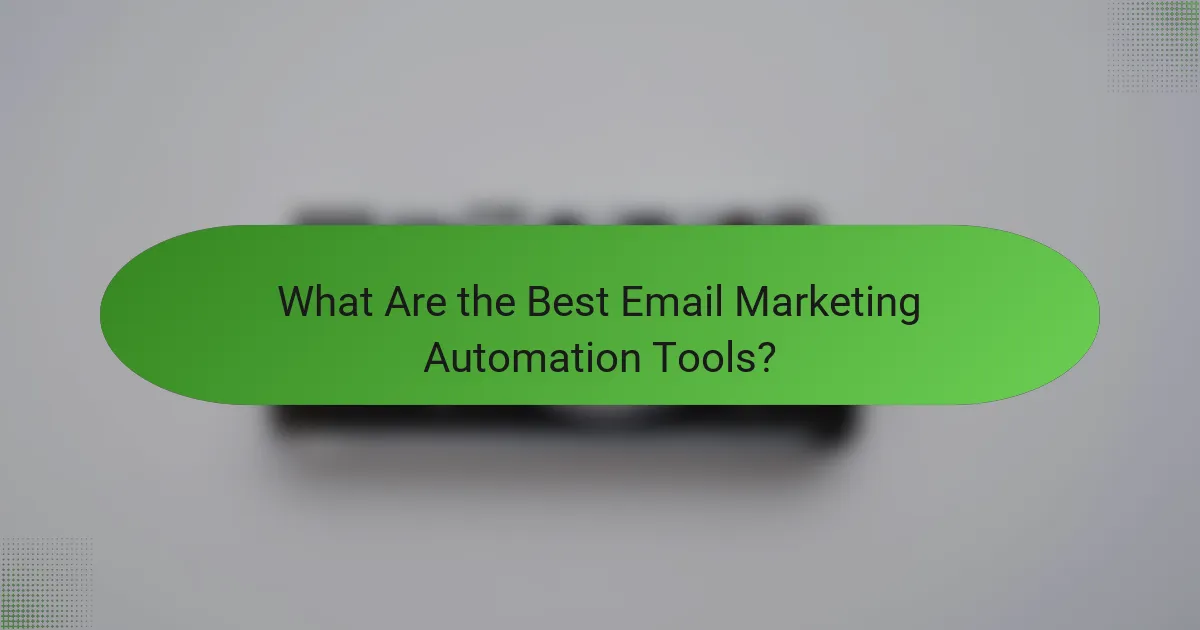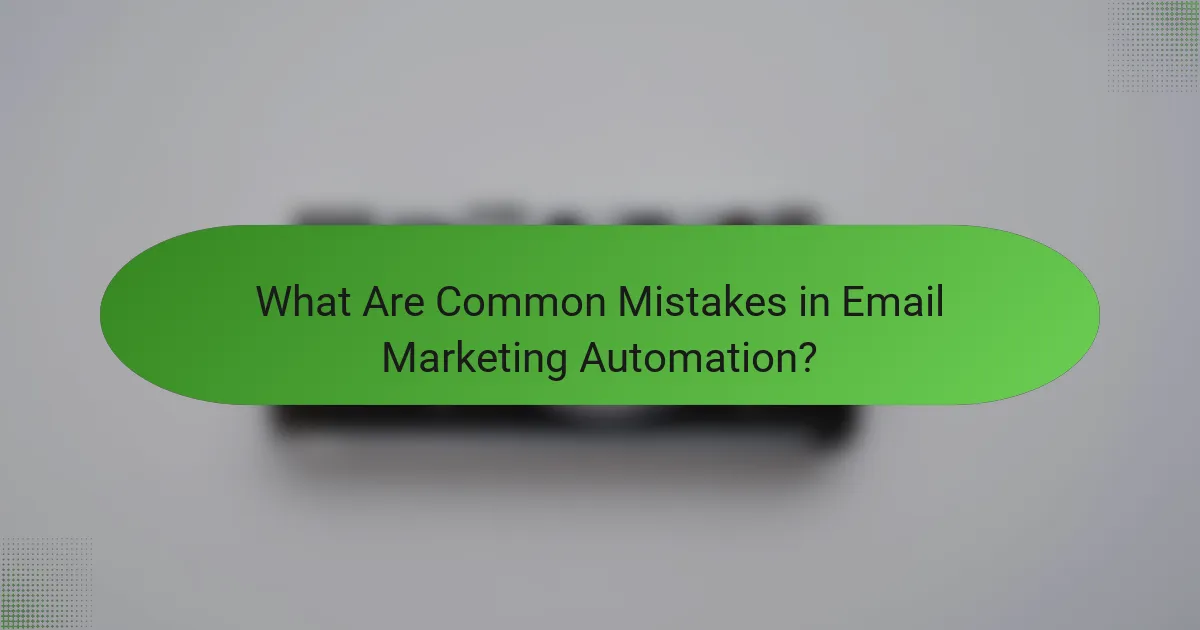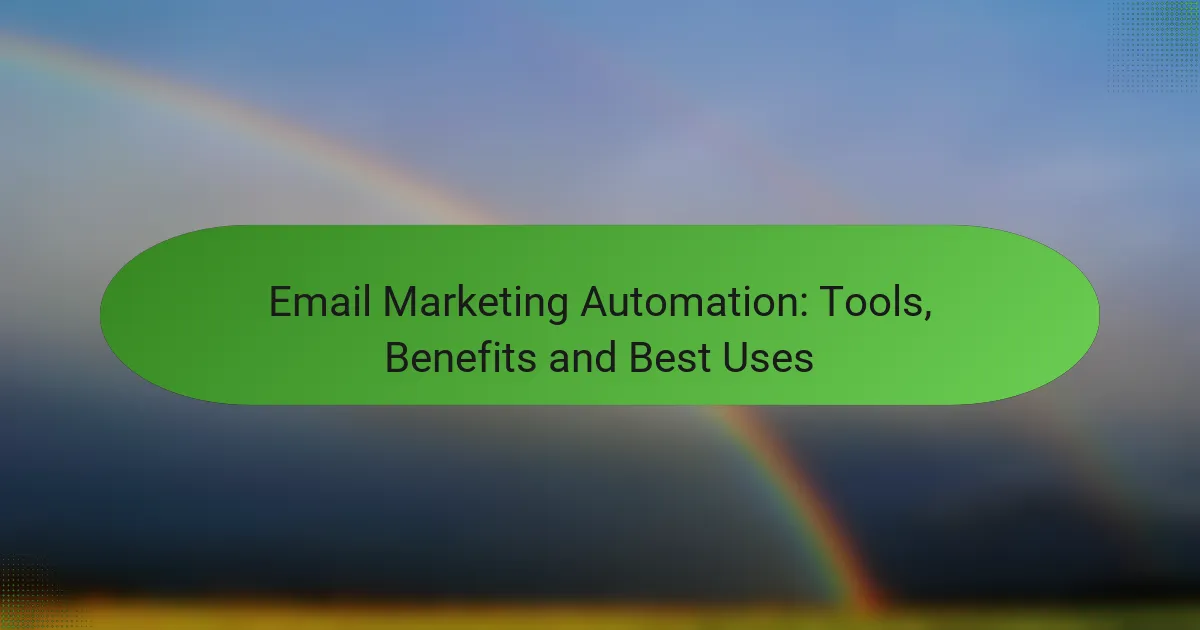Email marketing automation is a powerful strategy that helps businesses streamline their campaigns and boost customer engagement. By utilizing advanced tools, companies can automate repetitive tasks, deliver personalized content, and gain valuable insights into their audience’s behavior. This not only saves time but also enhances the overall effectiveness of marketing efforts, leading to improved conversion rates.

What Are the Best Email Marketing Automation Tools?
The best email marketing automation tools streamline your campaigns, enhance customer engagement, and improve conversion rates. They offer features like segmentation, analytics, and personalized messaging to optimize your marketing efforts.
Mailchimp
Mailchimp is a widely recognized email marketing automation tool known for its user-friendly interface and robust features. It allows businesses to create targeted campaigns using audience segmentation and provides detailed analytics to track performance.
With pricing plans ranging from free to premium, Mailchimp caters to various business sizes. The free plan includes basic automation features, while paid plans offer advanced options like A/B testing and custom templates.
HubSpot
HubSpot is an all-in-one marketing platform that includes powerful email marketing automation capabilities. It integrates seamlessly with CRM tools, allowing for personalized email campaigns based on customer interactions and behaviors.
HubSpot’s pricing is tiered, starting with a free version that offers basic features. As businesses grow, they can opt for paid plans that unlock advanced automation workflows and reporting tools.
ActiveCampaign
ActiveCampaign excels in providing advanced email marketing automation tailored for small to medium-sized businesses. Its features include dynamic content, predictive sending, and comprehensive customer journey mapping.
Pricing starts at a competitive rate, making it accessible for businesses looking to enhance their email marketing strategies. ActiveCampaign is particularly effective for those who prioritize customer relationship management alongside email marketing.
Sendinblue
Sendinblue offers a versatile email marketing automation solution with a focus on transactional emails and SMS marketing. It provides a straightforward drag-and-drop editor for creating visually appealing emails without needing design skills.
With a free plan that includes basic features, Sendinblue’s pricing is based on the number of emails sent rather than contacts, making it cost-effective for businesses with large mailing lists.
GetResponse
GetResponse is a comprehensive email marketing automation tool that includes features like landing page creation and webinar hosting. Its automation builder allows users to create complex workflows tailored to customer behavior.
GetResponse offers a free trial, with paid plans that provide access to advanced features such as conversion funnels and detailed analytics. This makes it suitable for businesses looking to integrate multiple marketing strategies into one platform.

What Are the Benefits of Email Marketing Automation?
Email marketing automation offers several advantages, including time savings, enhanced customer interactions, and better data insights. By automating repetitive tasks, businesses can focus on strategy while delivering timely and personalized content to their audience.
Increased Efficiency
Email marketing automation streamlines the process of sending campaigns, allowing businesses to schedule emails in advance and manage large lists effortlessly. This reduces the time spent on manual tasks and enables marketers to concentrate on crafting effective messages.
Using automation tools, companies can set up workflows that trigger emails based on user behavior, such as sign-ups or purchases. This ensures that relevant messages reach customers at the right moment, maximizing engagement without additional effort.
Personalized Customer Engagement
Automation allows for highly personalized email content tailored to individual preferences and behaviors. By segmenting audiences based on demographics or past interactions, businesses can send targeted messages that resonate more deeply with recipients.
For example, a retailer can automate follow-up emails with product recommendations based on previous purchases. This level of personalization can lead to higher open rates and conversion rates, as customers feel more valued and understood.
Improved Analytics and Reporting
Email marketing automation provides robust analytics that help businesses track the performance of their campaigns. Metrics such as open rates, click-through rates, and conversion rates can be easily monitored, offering insights into what works and what needs improvement.
By analyzing this data, marketers can refine their strategies and make informed decisions about future campaigns. Regularly reviewing these analytics can lead to continuous improvement, ensuring that email marketing efforts remain effective and aligned with business goals.

How to Choose the Right Email Marketing Automation Tool?
Choosing the right email marketing automation tool involves understanding your specific business needs, evaluating pricing plans, and considering integration capabilities. A well-suited tool can streamline your marketing efforts and enhance customer engagement.
Assess Your Business Needs
Start by identifying your marketing goals and the features you require. For instance, if you need advanced segmentation and analytics, look for tools that specialize in these areas. Understanding whether you need basic automation or more complex workflows will guide your selection.
Consider the size of your audience and the frequency of your campaigns. Some tools are better suited for small businesses with limited budgets, while others cater to larger enterprises with extensive needs. Make a list of must-have features to narrow down your options effectively.
Evaluate Pricing Plans
Pricing plans for email marketing automation tools can vary significantly, often ranging from free tiers to premium subscriptions. Assess what features are included at each price point and ensure they align with your budget. Look for tools that offer a trial period to test functionality before committing.
Be cautious of hidden costs, such as fees for additional subscribers or advanced features. A clear understanding of your expected growth can help you choose a plan that scales with your business without incurring unexpected expenses.
Consider Integration Capabilities
Integration with other tools is crucial for a seamless marketing strategy. Ensure the email marketing automation tool can connect with your existing CRM, e-commerce platform, and analytics software. This connectivity allows for better data management and enhanced customer insights.
Check for compatibility with popular platforms like Shopify, Salesforce, or WordPress. A tool that integrates well can save time and reduce manual work, leading to more efficient marketing operations. Look for user reviews that highlight integration experiences to inform your decision.

What Are the Best Practices for Email Marketing Automation?
Best practices for email marketing automation focus on effective audience engagement, continuous improvement, and adherence to legal standards. Implementing these strategies can enhance your campaign performance and ensure compliance with regulations.
Segment Your Audience
Segmenting your audience involves dividing your email list into smaller groups based on specific criteria such as demographics, purchase history, or engagement levels. This targeted approach allows for personalized messaging, which can significantly improve open and click-through rates.
Consider using criteria like location, interests, or past interactions to create segments. For example, a retail business might separate customers who frequently buy seasonal items from those who prefer everyday essentials. Tailoring content to these segments can lead to higher conversion rates.
Test and Optimize Campaigns
Regularly testing and optimizing your email campaigns is crucial for maximizing effectiveness. A/B testing different subject lines, content formats, or sending times can provide insights into what resonates best with your audience.
Use metrics such as open rates, click rates, and conversion rates to evaluate performance. Aim for continuous improvement by adjusting your strategies based on these results. For instance, if a particular subject line yields a significantly higher open rate, consider using similar wording in future campaigns.
Maintain Compliance with Regulations
Compliance with email marketing regulations, such as the General Data Protection Regulation (GDPR) in Europe or the CAN-SPAM Act in the United States, is essential to avoid legal issues. Ensure that you obtain explicit consent from recipients before sending marketing emails and provide a clear option to unsubscribe.
Familiarize yourself with the specific requirements for your target audience’s location. For example, GDPR mandates that businesses must keep records of consent and allow users to access their data. Adhering to these regulations not only protects your business but also builds trust with your audience.

How to Measure the Success of Email Marketing Automation?
Measuring the success of email marketing automation involves analyzing key performance indicators (KPIs) that reflect engagement and conversion. Focus on metrics like open rates, click rates, conversion rates, and subscriber growth to gauge effectiveness.
Track Open and Click Rates
Open and click rates are fundamental metrics for assessing the effectiveness of your email campaigns. The open rate indicates how many recipients opened your email, while the click rate shows how many clicked on links within it. A good open rate typically ranges from 15% to 25%, whereas click rates can vary from 2% to 5% depending on the industry.
To improve these rates, consider optimizing your subject lines and ensuring your email content is relevant and engaging. A/B testing different elements can also help identify what resonates best with your audience.
Analyze Conversion Rates
Conversion rates measure the percentage of recipients who take a desired action, such as making a purchase or signing up for a webinar. This metric is crucial for understanding the return on investment (ROI) of your email marketing efforts. Aim for a conversion rate of around 1% to 5%, depending on your goals and industry standards.
To enhance conversion rates, ensure your emails include clear calls to action (CTAs) and that the landing pages are optimized for user experience. Tracking conversions through analytics tools can provide insights into which campaigns are most effective.
Monitor Subscriber Growth
Subscriber growth reflects the health of your email list and the effectiveness of your marketing strategies. A steady increase in subscribers indicates that your content is valuable and that your acquisition strategies are working. Aim for a growth rate of at least 5% to 10% monthly to maintain a robust email list.
To foster subscriber growth, regularly clean your email list to remove inactive subscribers and encourage sign-ups through incentives like exclusive content or discounts. Engaging with your audience through surveys or feedback can also help improve retention and attract new subscribers.

What Are Common Mistakes in Email Marketing Automation?
Common mistakes in email marketing automation can significantly hinder campaign effectiveness. These errors often stem from poor segmentation, lack of personalization, and failure to monitor performance metrics.
Neglecting Audience Segmentation
One major mistake is failing to segment your audience properly. Without segmentation, emails may not resonate with specific groups, leading to lower engagement rates. It’s crucial to categorize your subscribers based on demographics, behavior, and preferences.
For example, a retail brand might segment its audience into categories like new customers, repeat buyers, and those who abandoned their carts. This allows for tailored messaging that speaks directly to each group’s needs.
Overlooking Personalization
Another common pitfall is neglecting personalization in your emails. Generic messages can feel impersonal and may lead to higher unsubscribe rates. Incorporating the recipient’s name, past purchase history, or tailored recommendations can enhance the user experience.
Utilizing dynamic content, where email content changes based on user data, can significantly improve engagement. For instance, sending personalized product recommendations based on previous purchases can drive conversions.
Ignoring Analytics and Performance Metrics
Failing to monitor analytics is a critical error that can derail your email marketing efforts. Without tracking key performance indicators (KPIs) like open rates, click-through rates, and conversion rates, you may miss opportunities for improvement.
Regularly reviewing these metrics allows you to adjust your strategies effectively. For example, if you notice a low open rate, consider testing different subject lines or sending times to optimize performance.
Not Testing Campaigns
Many marketers skip the testing phase, which can lead to missed opportunities for optimization. A/B testing different elements, such as subject lines, content, and call-to-action buttons, can provide valuable insights into what resonates with your audience.
Testing should be an ongoing process. For instance, if you find that emails sent on weekdays perform better than those sent on weekends, adjust your sending schedule accordingly.
